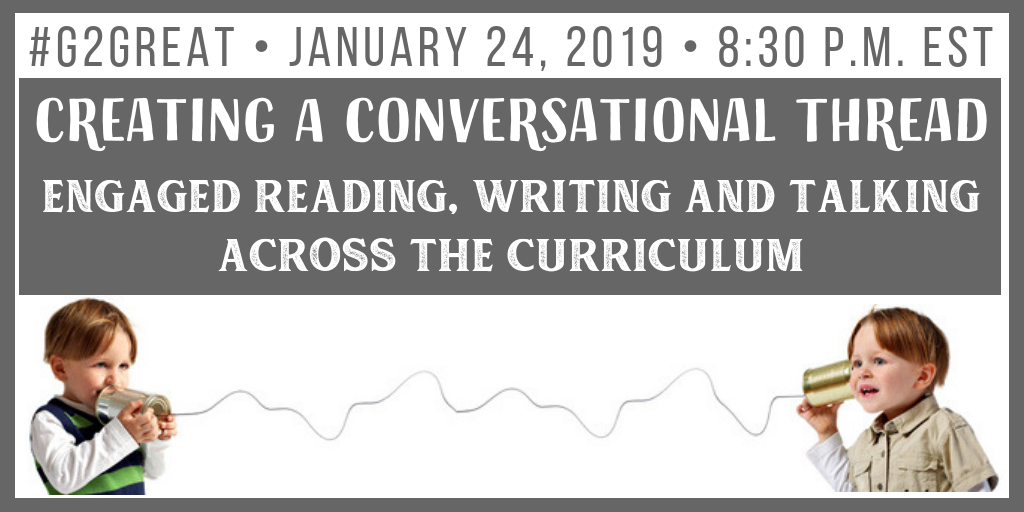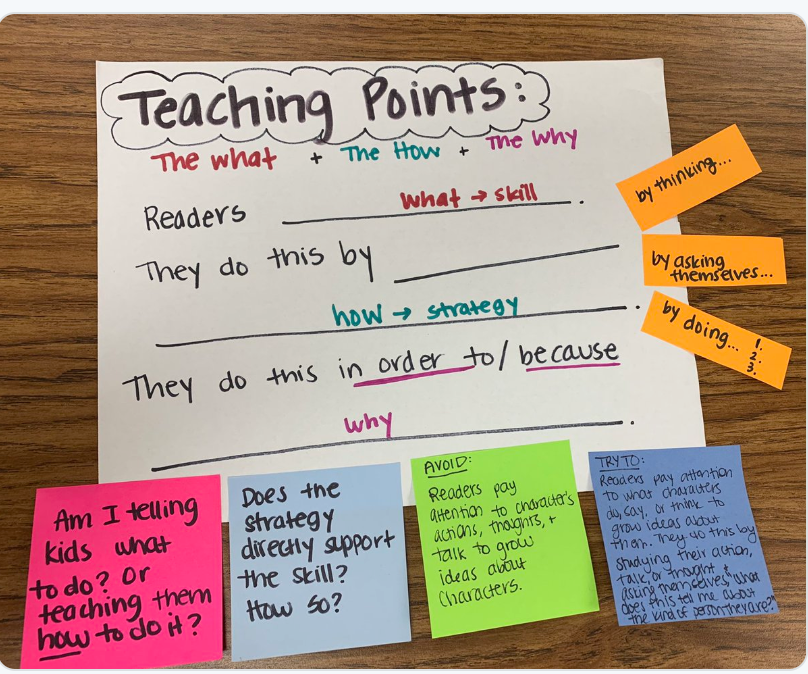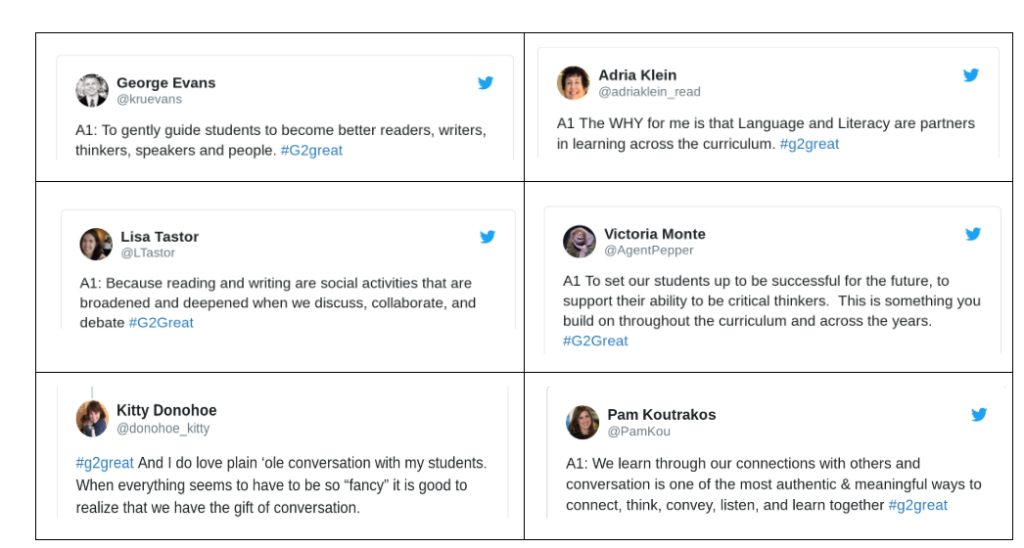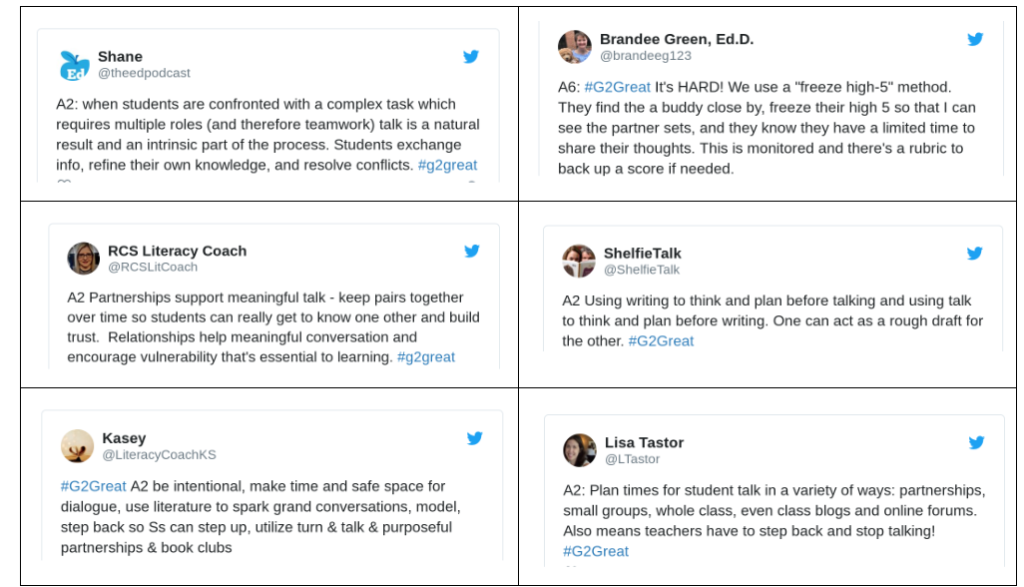By Fran McVeigh

Conversations? Thread? Engaged? Across the Curriculum? Where would the #G2Great chat focus on January 24th, 2019? Talk is typically either a conversation or discussion while a conversation is often defined as an expression and exchange of individual ideas through talking with other people (back and forth comments). The topic is broad, but the questions led to a laser-like focus on students and their learning. As I read through the Wakelet archive, the early ads, and the quotes, several themes emerged.
WHY?
This is an important question that we often seem to address, because without a ‘Why?’ as a focus, we would be adrift. And so an image from Liz Masi (TCRWP Staff Developer) in my Twitter Feed on Friday kept circling in my brain. Workshop, whether reading or writing, has long served as one instructional model that minimizes whole group instruction and maximizes student productivity in terms of time to work . . . talk, and thinking. How does the structure of a 10 – 12 minute mini-lesson in a 60 minute learning workshop do that? A mini-lesson is focused on one teaching point. And that teaching point has a Why? a What? and a How? as shown here.

And the organizational structure for my post was found!
Tweets from the chat that support the WHY:
WHAT?
Talk and Conversation is oral communication. Time spent talking can spark new ideas, convey understanding, clarify misunderstandings, capture in-the-moment thinking, and consolidate learning. But to be both effective and efficient in classrooms today, who is doing the talking? Is it the teacher? The students? Or a combination of both?
Peter Johnston provided many examples of how language affects learning in Choice Words. Attention to both skills and relationships increases the effectiveness of talk. Teachers and students can refer to his research to consider how to deepen learning to arrive at the ultimate transfer goal.
I was fascinated by some research studies that I quickly found through Google Scholar where Teacher Talk Time (TTT) was studied both qualitatively and quantitatively. Aha! Would descriptors lead to deeper understanding? Would there be recommended times or allotments? Like many research efforts, I was left with more questions unanswered. What would define quality teacher talk? What would define quality student talk? How would teachers and students agree? How should time be allocated?
Tweets from our chat that support the WHAT:
HOW?
How will we ensure that conversational threads are established across the day in all classrooms? An initial data point could be student and teacher perceptions of classroom talk. In terms of percentages, what percentage of time is spent on Teacher Talk, Teacher-Student Talk, and Student Talk? A comparison of perception to an actual coding of classroom instruction could verify that perceptual data. Then the discussion could move to whether a change is needed (significantly higher Student Talk than Teacher Talk) or if the status quo is meeting the needs of the learners or the values (the Why?) of the organization. If a change is needed, more information, more study, proposed actions, goal setting . . . all of these could be considered.
Tweets from our chat that support the HOW:
I would be remiss if I didn’t remind readers of another powerful source, Kara Prantikoff’s Teaching Talk: A Practical Guide to Fostering Student Thinking and Conversation highlighted in this May 18, 2017, #G2Great chat and blog post. This text is a “must have” for teachers who intend to expand student talk as it is grounded in the research, pedagogy, assessment tools, formats, and reflection methods that enhance instruction.
WHY?
Returning to the beginning. . .
The whole point of increasing the quantity and quality of student talk is not about adding in more interrogations or teacher questioning and student answering sessions. A thoughtful review of existing conditions is required. Are students provided time to have conversations, both planned and spontaneous, across the day? Are conversations only allowed after the “teacher is done talking”? Where is the balance in student work and talk? Does it make a difference if you use a “Gradual Release of Responsibility” or if you have a “collaborative classroom”?
Under the “Gradual Release of Responsibility”, teacher talk is not the major focus of time. In many classrooms, Teacher Talk may be be 30-40% of the time with some students then working in small groups or partnerships for a bigger percentage of the time. However, some students may need more support so a “one size fits all” model is never required. And yet a key for this is the fact that the support can and should come from peers. Teachers do not have to provide all the affirmations or answers. Collaborative classrooms provide space and security for students to work together and talk. Collaboration skills and practice are important across the curriculum and the entire day. Learning classrooms are buzzing with conversation. The old maxim, “Students should be seen, not heard” should be the very opposite of classrooms of today. Tables and conversational areas should be strategically placed in classrooms to invite conversations, deepen learning, and create threads of understanding and thinking that permeate the entire learning day.
So what?
My kids are learning; I know they are!
If you have made it this far, I would now challenge you to reflect on your own classroom practices. Check your data on the amount of time that you TALK in your classroom. Start with your teaching point. Do you deliver those three sentences in less than one minute? Does it take you five minutes? If so, you may be working with teaching chapters instead of teaching points. Maybe you need a more specific focus that allows you to explicitly teach one piece at a time.
If we go back to the beginning and the mini-lesson example, that whole class instruction based on Teacher Talk is tightly focused for approximately 10-12 minutes. That is 1 / 6 th of an hour; sixty minutes. So what does that really look like across the day? If you have an 8 period class day, that would mean that you would really only have about 80 minutes of Teacher Talk Time across the day. Who’s Really Doing the Work? The Teacher? Or the Students? Who needs to be doing the talking work? How do we know who is doing the work? Who needs to be creating those conversational threads across the day?
Now What?
Where will you begin? Where will your exploration start? The quality of Teacher Talk Time? The amount of Teacher Talk Time? The quality of Student Talk Time? The amount of Student Talk Time? Student Talk time totally initiated by students to meet their needs with ZERO teacher supervision. Choose your burning question, develop a plan, and improve the dreary winter months by increasing conversational threads across the day!


